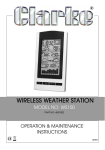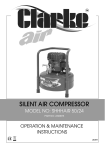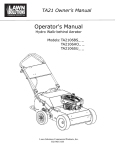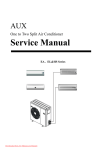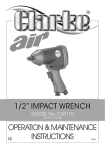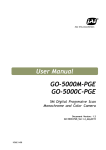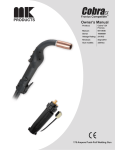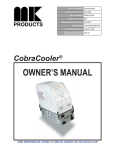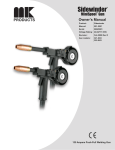Download Clarke ARC Specifications
Transcript
ARC/TIG INVERTER MODEL NO: AT131 PART NO: 6012230 OPERATION & MAINTENANCE INSTRUCTIONS LS0309 INTRODUCTION Thank you for purchasing this CLARKE ARC/TIG INVERTER. Before attempting to use this product, please read this manual thoroughly and follow the instructions carefully. In doing so you will ensure the safety of yourself and that of others around you, and you can look forward to your purchase giving you long and satisfactory service. GUARANTEE This product is guaranteed against faulty manufacture for a period of 12 months from the date of purchase. Please keep your receipt which will be required as proof of purchase. This guarantee is invalid if the product is found to have been abused or tampered with in any way, or not used for the purpose for which it was intended. Faulty goods should be returned to their place of purchase, no product can be returned to us without prior permission. This guarantee does not effect your statutory rights. PARTS AND SERVICING For Parts & Servicing, please contact your nearest dealer, or CLARKE International, on one of the following numbers. PARTS & SERVICE TEL: 020 8988 7400 PARTS & SERVICE FAX: 020 8558 3622 or e-mail as follows: PARTS: [email protected] SERVICE: [email protected] 2 TABLE OF CONTENTS INTRODUCTION................................................................ 2 GUARANTEE ..................................................................... 2 PARTS AND SERVICING ................................................... 2 TABLE OF CONTENTS........................................................ 3 ELECTROMAGNETIC INTERFERENCE (EMC) .................... 4 SAFETY PRECAUTIONS ..................................................... 6 PREPARATION OF THE WORKING AREA ......................... 11 SAFETY EQUIPMENT.......................................................... 11 ADDITIONAL PRECAUTIONARY MEASURES .................... 11 SAFETY PRECAUTIONS FOR ARC/TIG WELDING ............. 12 SYMBOLS .......................................................................... 13 PRINCIPLES OF OPERATION ............................................ 14 ELECTRICAL CONNECTIONS ........................................... 16 WELDING TECHNIQUES.................................................... 17 MAINTENANCE ................................................................ 21 ACCESSORIES .................................................................. 21 SPECIFICATIONS .............................................................. 22 EXPLODED DIAGRAM & PARTS LIST ................................ 23 WIRING DIAGRAM........................................................... 24 DECLARATION OF CONFORMITY.................................... 25 NOTES ............................................................................... 26 NOTES ............................................................................... 27 3 ELECTROMAGNETIC INTERFERENCE (EMC) Whilst this unit complies with EMC regulations, the user is responsible for installing and using the welding equipment according to the manufacturers instructions. If electromagnetic disturbances are detected then it shall be the responsibility of the user of the welding equipment to resolve the situation. In some cases this remedial action may be as simple as earthing the welding circuit, see ‘Note’. In other cases it could involve constructing an electromagnetic screen enclosing the power source and the work complete with associated input filters. In all cases electromagnetic disturbances must be reduced to the point where they are no longer troublesome. NOTE: The welding circuit may or may not be earthed for safety reasons. Changing the earthing arrangements should only be authorised by a person who is competent to assess whether the changes will increase the risk of injury, e.g. by allowing parallel welding current return paths which may damage the earth circuits of other equipment. 1. ASSESSMENT OF AREA Before installing welding equipment the user shall make an assessment of potential electromagnetic problems in the surrounding area. Avoid using your inverter in the vicinity of: a. other supply cables, control cables, signalling and telephone cables; above, below and adjacent to the welding equipment; b. radio and television transmitters and receivers; c. computer and other control equipment; d. safety critical equipment, e.g. guarding of industrial equipment; e. pacemakers and hearing aids etc; f. equipment used for calibration or measurement; g. other equipment in the environment. The user shall ensure that other equipment being used in the environment is compatible. This may require additional protection measures; It may be possible to avoid the above by changing the time of day that welding or other activities are to be carried out. The size of the surrounding area to be considered will depend on the structure of the building and other activities that are taking place. The surrounding area may extend beyond the boundaries of the premises. 4 2. METHODS OF REDUCING EMISSIONS 2.1 MAINS SUPPLY Welding equipment should be connected to the mains supply according to the manufacturers recommendations. If interference occurs, it may be necessary to take additional precautions such as filtering of the mains supply. Consideration should be given to shielding the supply cable of permanently installed welding equipment, in metallic conduit or equivalent. Shielding should be electrically continuous throughout its length. The shielding should be connected to the welding power source so that good electrical contact is maintained between the conduit and the welding power source enclosure. 2.2 MAINTENANCE OF THE WELDING EQUIPMENT The welding equipment should be routinely maintained according to the manufacturers recommendations. All access and service doors and covers should be closed and properly fastened when the welding equipment is in operation. The welding equipment should not be modified in any way except for those changes and adjustments covered in the manufacturers instructions. In particular, the spark gaps of arc striking and stabilizing devices should be adjusted and maintained according to the manufacturers recommendations. 2.3 WELDING CABLES The welding cables should be kept as short as possible and should be positioned close together, running at or close to the floor level. 2.4 EQUIPOTENTIAL BONDING Bonding of all metallic components in the welding installation and adjacent to it should be considered. However, metallic components bonded to the work piece will increase the risk that the operator could receive a shock by touching these metallic components and the electrodes at the same time. The operator should be insulated from all such bonded metallic components. 2.5 EARTHING OF THE WORKPIECE Where the workpiece is not bonded to earth for electrical safety, nor connected to earth because of its size and position, e.g. ships hull or building steelwork, a connection bonding the workpiece to earth may reduce emissions in some, but not all instances. Care should be taken to prevent the earthing of the workpiece increasing the risk of injury to users, or damage to other electrical equipment. Where necessary, the connection of the workpiece to earth should be made by a direct connection to the workpiece, but in some countries where direct connection is not permitted, the bonding should be achieved by suitable capacitance, selected according to national regulations. 5 2.6 SCREENING AND SHIELDING Selective screening and shielding of other cables and equipment in the surrounding area may alleviate problems of interference. Screening of the entire welding installation may be considered for special applications. SAFETY PRECAUTIONS WARNING: AS WITH ALL MACHINERY, THERE ARE CERTAIN HAZARDS INVOLVED WITH THEIR OPERATION AND USE. EXERCISING RESPECT AND CAUTION WILL CONSIDERABLY LESSEN THE RISK OF PERSONAL INJURY. HOWEVER, IF NORMAL SAFETY PRECAUTIONS ARE OVERLOOKED, OR IGNORED, PERSONAL INJURY TO THE OPERATOR MAY RESULT. FAILURE TO FOLLOW THESE RULES MAY RESULT IN SERIOUS PERSONAL INJURY. 1. GENERAL PRECAUTIONS A) BURN PREVENTION Wear protective clothing - gauntlet gloves designed for use in welding, hat, and protective shoes. Button shirt collar and pocket flaps, and wear cuffless trousers to avoid entry of sparks and slag. Wear helmet with safety goggles or glasses with side shields underneath, appropriate filter lenses or plates (protected by clear cover glass). This is a MUST for welding or cutting, (and chipping) to protect the eyes from radiant energy and flying metal. Replace cover glass when broken, pitted, or spattered. Avoid oily greasy clothing. A spark may ignite them. Hot metal such as electrode stubs and workpieces should never be handled without gloves. First aid facilities and a qualified first aid person should be available for each shift unless medical facilities are close by for immediate treatment of flash burns of the eyes and skin burns. Ear plugs should be worn when working overhead or in a confined space. A hard hat should be worn when others work overhead. Flammable hair preparations should not be used by persons intending to weld or cut. B) TOXIC FUME PREVENTION Severe discomfort, illness or death can result from fumes, vapours, heat, or oxygen enrichment or depletion that welding (or cutting) may produce. Prevent them with adequate ventilation. NEVER ventilate with oxygen. Lead-, cadmium-, zinc-, mercury- and beryllium-, bearing materials, when welded (or cut) may produce harmful concentrations of toxic fumes. Adequate local exhaust ventilation must be used, or each person in the area as well as the operator must wear an air- supplied respirator. For beryllium, both must be used. Metals coated with or containing materials that emit toxic fumes should not be heated unless coating is removed from the work surface, the area is well ventilated, or the operator wears an air-supplied respirator. Work in a 6 confined space only while it is being ventilated and, if necessary, while wearing an air-supplied respirator. Vapours from chlorinated solvents can be decomposed by the heat of the arc (or flame) to form PHOSGENE, a highly toxic gas, and other lung and eye irritating products. The ultraviolet (radiant) energy of the arc can also decompose trichloroethylene and perchloroethylene vapours to form phosgene. DO NOT WELD or cut where solvent vapours can be drawn into the welding or cutting atmosphere or where the radiant energy can penetrate to atmospheres containing even minute amounts of trichloroethylene or perchloroethylene. C) FIRE AND EXPLOSION PREVENTION Causes of fire and explosion are: 1. combustibles reached by the arc, flame, flying sparks, hot slag or heated material; 2. misuse of compressed gases and cylinders; 3. short circuits. BE AWARE THAT flying sparks or falling slag can pass through cracks, along pipes, through windows or doors, and through wall or floor openings, out of sight of the goggled operator. Sparks and slag can fly 10m. To prevent fires and explosion: keep equipment clean and operable, free of oil, grease, and (in electrical parts) of metallic particles that can cause short circuits. If combustibles are in area, do NOT weld or cut. Move the work if practicable, to an area free of combustibles. Avoid paint spray rooms, dip tanks, storage areas, ventilators. If the work cannot be moved, move combustibles at least 10m. away out of reach of sparks and heat; or protect against ignition with suitable and snug fitting, fireresistant covers or shields. Walls touching combustibles on opposite sides should not be welded on (or cut). Walls, ceilings, and floor near work should be protected by heat resistant covers or shields. Fire watcher must be standing by with suitable fire extinguishing equipment during and for some time after welding or cutting if: a. appreciable combustibles (including building construction) are within 10m. b. appreciable combustibles are further than 10m but can be ignited by sparks. c. openings (concealed or visible) in floors or walls within 10m can expose combustibles to sparks. d. combustibles adjacent to walls, ceilings, roofs or metal partitions can be ignited by radiant or conducted heat. After work is done, check that area is free of sparks, glowing embers, and flames. An empty container that held combustibles, or that can produce 7 flammable or toxic vapours when heated, must never be welded on or cut, unless container has first been cleaned. This includes.......a thorough steam or caustic cleaning (or a solvent or water washing, depending on the combustible’s solubility) followed by purging and inerting with nitrogen or carbon dioxide, and using protective equipment. Water filling just below working level may substitute for inerting. A container with unknown contents should be cleaned (see paragraph above), do NOT depend on sense of smell or sight to determine if it is safe to weld or cut. Hollow castings or containers must be vented before welding or cutting - they can explode. In explosive atmospheres, never weld or cut where the air may contain flammable dust, gas, or liquid vapours. 2. ELECTRIC ARC (MIG, TIG) WELDING Comply with precautions in 1, and this section. Arc welding, properly done, is a safe process, but a careless operator invites trouble. The equipment carries high currents at significant voltages. The arc is very bright and hot. Sparks fly, fumes rise, ultraviolet and infrared energy radiates, weldments are hot. The wise operator avoids unnecessary risks and protects himself and others from accidents. 2A) BURN PROTECTION Comply with precautions in 2. The welding arc is intense and visibly bright. Its radiation can damage eyes, penetrate lightweight clothing, reflect from light coloured surfaces, and burn the skin and eyes. Skin burns resemble acute sunburn, those from gas - shielded arcs are more severe and painful. DON’T GET BURNED! COMPLY WITH PRECAUTIONS! 1) PROTECTIVE CLOTHING Wear long sleeved clothing (particularly for gas shielded arc) in addition to gloves, hat and shoes (2A). As necessary, use additional protective clothing such as leather jacket or sleeves, flameproof apron, and fire-resistant leggings. Avoid outer garments of untreated cotton. Bare skin protection. Wear dark substantial clothing. Button collar to protect chest and neck and button pockets to prevent entry of sparks. 2) EYE AND HEAD PROTECTION Protect eyes from exposure to arc. NEVER look at an electric arc without protection. Welding helmet or shield containing a filter plate shade no. 12 or denser must be used when welding. Place over face before striking arc. Protect filter plate with a clear cover plate. Cracked or broken helmet or shield should NOT be worn; radiation can pass through to cause burns. Cracked, broken, or loose filter plates must be replaced IMMEDIATELY. Replace clear cover plate when broken, pitted, or spattered. WE SUGGEST 8 you wear flash goggles with side shields under the helmet, to give some protection to the eyes should the helmet not be lowered over the face before an arc is struck. Looking at an arc momentarily with unprotected eyes (particularly a high intensity gas-shielded arc) can cause a retinal burn that may leave a permanent dark area in the field of vision. Before welding whilst wearing contact lenses, seek advice from your optician. 3) PROTECTION OF NEARBY PERSONNEL For production welding, a separate room or enclosed bay is best. In open areas, surround the operation with low reflective, non- combustible screens or panels. Allow for free air circulation, particularly at floor level. Provide face shields for all persons who will be looking directly at the weld. Others working in the area should wear flash goggles. Before starting to weld, make sure that screen or bay doors are closed. 2B) TOXIC FUME PREVENTION Comply with precautions in 2-B. Generator engine exhaust must be vented to the outside air. Carbon monoxide can kill. 2C) FIRE AND EXPLOSION PREVENTION Comply with precautions in 2-C. Equipment’s rated capacity. Do not overload arc welding equipment. It may overheat cables and cause a fire. Loose cable connections may overheat or flash and cause a fire. Never strike an arc on a cylinder or other pressure vessel. It creates a brittle area that can cause a violent rupture or lead to such a rupture later under rough handling. 2D) SHOCK PREVENTION Exposed live conductors or other bare metal in the welding circuit, or in unearthed, electrically-LIVE equipment can fatally shock a person whose body becomes a conductor. DO NOT STAND, SIT, LIE, LEAN ON, OR TOUCH a wet surface when welding, without suitable protection. 2E) PROTECTION FOR WEARERS OF ELECTRONIC LIFE SUPPORT DEVICES (PACEMAKERS) Magnetic fields from high currents can affect pacemaker operation. Persons wearing electronic life support equipment (pacemaker) should consult with their doctor before going near arc welding, gouging, or spot welding operations. 2F) TO PROTECT AGAINST SHOCK: Keep body and clothing dry. Never work in damp area without adequate insulation against electrical shock. Stay on a dry duckboard, or rubber mat when dampness or sweat can not be avoided. Sweat, sea water, or moisture between body and an electrically LIVE part - or earthed metal - reduces the 9 body surface electrical resistance, enabling dangerous and possibly lethal currents to flow through the body. 1) EARTHING THE EQUIPMENT When arc welding equipment is earthed according to the National Electrical Code, and the work is earthed, a voltage may exist between the electrode and any conducting object. Examples of conducting objects include, but are not limited to, buildings, electrical tools, work benches, welding power source cases, workpieces, etc. Never touch the electrode and any metal object unless the welding power source is off. When installing, connect the frames of each unit such as welding power source, control, work table, and water circulator to the building earth. Conductors must be adequate to carry earth currents safely. Equipment made electrically LIVE by stray current may shock, possibly fatally. Do NOT EARTH to electrical conduit, or to a pipe carrying ANY gas or a flammable liquid such as oil or fuel. 2) ELECTRODE HOLDERS Fully insulated electrode holders should be used. Do NOT use holders with protruding screws or with any form of damage. 3) CONNECTORS Fully insulated lock-type connectors should be used to join welding cable. 4) CABLES Frequently inspect cables for wear, cracks and damage. IMMEDIATELY REPLACE those with excessively worn or damaged insulation to avoid possibly lethal shock from bared cable. Cables with damaged areas may be taped to give resistance equivalent to original cable. Keep cable dry, free of oil and grease, and protected from hot metal and sparks. 5) TERMINALS AND OTHER EXPOSED PARTS Terminals and other exposed parts of electrical units should have insulating covers secured before operation. 6) ELECTRODE a. Equipment with output on/off control (contactor) Welding power sources for use with the gas metal arc welding, gas tungsten arc welding and similar processes normally are equipped with devices that permit on/off control of the welding power output. When so equipped the electrode wire becomes electrically LIVE when the power source switch is ON and welding gun switch is closed. Never touch the electrode wire or any conducting object in contact with the electrode circuit unless the welding power source is off. b. Equipment without output on/off control (no contactor) Welding power sources used with shielded metal arc welding and similar 10 processes may not be equipped with welding power output on/off control devices. With such equipment the electrode is electrically LIVE when the power switch is turned ON. Never touch the electrode unless the welding power source is off. 7) SAFETY DEVICES Safety devices such as interlocks and circuit breakers should not be disconnected or shunted out. Before installation, inspection, or service of equipment, shut OFF all power and remove line fuses (or lock or red-tag switches) to prevent accidental turning ON of power. Do not open power circuit or change polarity while welding. If, in an emergency, it must be disconnected, guard against shock burns, or flash from switch arcing. Always shut OFF and disconnect all power to equipment. Power disconnect switch must be available near the welding power source. PREPARATION OF THE WORKING AREA The working area must be sufficiently spacious, not humid, and well-ventilated as to avoid any fumes which develop from the welding process and from incidental material adhering to the pieces to be welded (oils, paints, tars...) which may cause annoyance to the operator. Avoid welding by contact with humid parts nearby combustible liquids. Least of all, do not weld upon tanks which may contain inflammable residuals. SAFETY EQUIPMENT A comprehensive range of CLARKE safety equipment for use when welding is available from your local CLARKE dealer. ADDITIONAL PRECAUTIONARY MEASURES IMPORTANT: The TIG machine generates both airborne and line interference due to the high frequencies involved. It is important not to locate electronic or electrically sensitive equipment in the vicinity of the welder or alternatively, do not locate the welder in vicinity of electronic or electrically sensitive equipment. 11 SAFETY PRECAUTIONS FOR ARC/TIG WELDING ALWAYS ensure that there is full free air circulating around the outer casing of the machine, and that the louvres are unobstructed. ALWAYS use a proper welding face shield or helmet, with suitable filter lenses. Proper gloves and working clothes should be worn at all times. ALWAYS check that the pressure regulator and gauges are working correctly. DO NOT lubricate the regulator. ALWAYS use the correct regulator. Each regulator is designed to be used with a specific gas. ALWAYS inspect the hose before use to ensure it is in good condition. ALWAYS keep the free length of gas hose outside the work area. ALWAYS remove all flammable materials from the welding area. NEVER remove any of the panels unless the machine is disconnected from the supply, AND never use the machine with any of the panels removed. NEVER attempt any electrical or mechanical repair unless your are a qualified technician. If you have a problem with the machine contact your local CLARKE dealer. NEVER use or store in a wet/damp environment. DO NOT EXPOSE TO RAIN. NEVER use gas from a cylinder, the content of which is unknown. The Tig welding process uses an INERT gas to protect the weld pool. It is important to ensure the appropriate gas is being used. NEVER use a damaged cylinder. NEVER lift the cylinder by the valve. NEVER expose the cylinder to a heat source or sparks. NEVER continue to weld, if, at any time, you feel even the smallest electric shock. Stop welding IMMEDIATELY, and DO NOT attempt to use the machine until the fault is diagnosed and corrected. NEVER use the welder with input connections greater than 10M in length. NEVER point the TIG torch at any person or animal. NEVER touch the TIG torch nozzle until the welder is switched OFF and the nozzle has been allowed to cool off. NEVER connect, disconnect, or attempt to service the TIG torch, until the machine is switched OFF and disconnected from the mains supply. NEVER allow the cables to become wrapped around the operator or any person in the vicinity. 12 SYMBOLS The following symbols will appear on your welder Direct Current (DC) Line connection Single Phase Static Frequency ConverterTransformer-Rectifier Shielded Metal Arc Weilding (SMAW) Constant current Read instructions before using the welder. Dangerous voltage 13 PRINCIPLES OF OPERATION The ARC/TIG welder, as its name suggests, is designed to be used for both Metal ARC/ TIG welding. To accomplish this, two sets of welding leads are required, one for each method employed. Tig welding leads are not supplied with the machine. These are readily available from your CLARKE dealer. 1. ARC WELDING Shielded Metal Arc welding employs the heat of the arc to melt the base metal and the tip of a flux covered electrode. The electrode and the workpiece are part of an electric circuit. This circuit begins with the electric power source and includes the welding cables, an electrode holder, a workpiece connection, the workpiece, and an arc welding electrode. One of the two cables from the power source is attached to the work. The other is attached to the electrode holder. Welding commences when an electric arc is struck between the tip of the electrode and the work. The intense heat of the arc melts the tip of the electrode and the surface of the work close to the arc. Tiny globules of molten metal rapidly form on the tip of the electrode, then transfer through the arc stream into the molten weld pool. In this manner, filler metal is deposited as the electrode is progressively consumed. The arc is moved over the work at an appropriate arc length and travel speed, melting and fusing a portion of the base metal and continuously adding filler metal. Since the arc is one of the hottest of the commercial sources of heat (temperatures above 90000F (50000C) have been measured at its centre), melting of the base metal takes place almost instantaneously upon arc initiation. If welds are made in either the flat or the horizontal position, metal transfer is induced by the force of gravity, gas expansion, electric and electromagnetic forces, and surface tension. For welds in other positions, gravity works against the other forces. The process requires sufficient electric current to melt both the electrode and a proper amount of base metal. It also requires an appropriate gap between the tip of the electrode and the base metal or the molten weld pool. These requirements are necessary to set the stage for coalescence. The sizes and types of electrodes for shielded metal arc welding define the arc voltage requirements (within the overall range of 16 to 40V) and the current requirements (within the overall range of 20 to 550A). The current may be either alternating or direct, depending upon the electrode being used, but the power source must be able to control the level of current within a reasonable range in order to respond to the complex variables of the welding process itself. 14 2. TIG WELDING TIG welding is primarily a DC current process, but can also utilise AC, usually for very thin materials and when welding Aluminium or other non ferrous metals. It uses a non-consumable tungsten (or tungsten alloy) electrode, held in a torch. Shielding gas (100% Argon), is fed through the torch to protect a. the electrode, b. molten weld pool, and c. solidifying weld metal from contamination by the atmosphere. The electric arc is produced by the passage of current through the conductive, ionized shielding gas. The arc is established between the tip of the electrode and the work. Heat generated by the arc melts the base metal. Once the arc and weld pool are established, the torch is moved along the joint and the arc progressively melts the joined surfaces. Filler wire, if used, is usually added to the leading edge of the weld pool to fill the joint. This process is ideally suited for welding thin metals, pressure vessels, heat exchangers, pipes etc., where accuracy and a high quality weld is desired, as it produces a very low porosity weld. MAIN FEATURES OF TIG WELDING 1. Welds all metals. 2. Electronic control of welding current. 3. Forced air cooling. 4. A thermal overload protection device prevents overheating the transformer. TIG WELDING PROCESS ADVANTAGES • It produces superior quality welds, generally free of defects. • It is free of the spatter which occurs with other arc welding processes. • It can be used with or without filler metal as required. • It allows excellent control of root pass weld penetration. • It can produce inexpensive autogenous welds at high speeds. • It allows precise control of the welding variables. • Capable of welding very thin material (0.5mm), without undue distortion. LIMITATIONS 1. Greater weld dexterity is required. 2. It is more expensive to weld thicker materials - greater than 4 - 5mm. 15 ELECTRICAL CONNECTIONS Connect the mains lead to a 230 Volt (50Hz) single phase 32 amp electrical supply, through a suitably fused isolator. WARNING: DO NOT CONNECT TO A DOMESTIC SYSTEM VIA A 13 AMP PLUG. WARNING: THIS APPLIANCE MUST BE EARTHED IMPORTANT: The wires in the mains lead are coloured in accordance with the following code: Green & Yellow Blue Brown - Earth Neutral Live • Connect GREEN & YELLOW cord to terminal marked with a letter “E” or Earth symbol “ ” or coloured GREEN or GREEN & YELLOW. • Connect BROWN cord to terminal marked with a letter “L” or coloured RED. • Connect BLUE cord to terminal marked with a letter “N” or coloured BLACK. We recommend that this machine is connected to the mains supply via a Residual Current Device (RCD) If in any doubt, DO NOT attempt any connections or repairs yourself. Consult a qualified electrician, your local Clarke dealer or Clarke International on: 020 8988 7400 or e-mail [email protected] CABLE EXTENSION Always use an approved extension cable suitable for the power rating of this tool (see specifications), the conductor size should also be at least the same size as that on the machine, or larger. When using cable reel, always unwind the cable completely. IMPORTANT If a cable extension is needed, it is essential to comply with the following data. Voltage Extension length Cable section 230V up to 20 Meters 2.5mm2 230V 20 - 50 Meters 4mm2 16 WELDING TECHNIQUES ARC WELDING Arc welding cables are supplied with this machine. To prepare the unit for ARC welding, it is important that you follow the procedure below. 1. With the ON/OFF switch, located on the rear panel, in the OFF position, connect the welding leads as follows: Fig 1 • Welding Electrode lead to the +ve terminal. • Work Clamp lead to the -ve terminal. 2. Attach the work clamp to the workpiece - as close as possible to the area being welded. Clean with a wire brush where necessary to ensure the connection is as clean as possible. 3. An appropriate current must then be set by turning the Welding Current Selector located on the front panel of the machine. With practice you will gain a feel for the correct current setting for different welding rod thicknesses. The size (diameter) of welding rod should be approximately the same as the thickness of metal to be welded. For beginners, the following table gives some useful guidelines. Size Of the Welding Rod Thickness of the Workpiece 1.5 mm 16 SWG - 1.5 MM. 30-40 2.0 mm 14 SWG - 2.0 MM. 50 - 65 2.5 mm 12 SWG - 2.5 MM. 70 - 100 3.0 mm 10 SWG - 3.25MM 100 - 125 17 Current setting (Amps) 4. Switch ON using the switch located on the rear panel. The green light on the front panel should glow, indicating the machine is ON. NOTE: If the machine stops at any time and the amber light comes ON the thermal overload has intervened. 5. The most difficult aspect of the arc welding process, particularly for beginners, is that of striking an arc. We strongly recommend that you practice on some pieces of scrap metal to get the feel of the operation, before you start on an actual welding job. 6. Hold the electrode about 10mm from the work and at an angle of about 70° to 80° to the work surface; take care not to accidentally touch the workpiece until you are ready to commence. 7. Holding the welding mask close-up to the face, give a short stroke with the electrode on the workpiece. As soon as the arc is primed, withdraw the electrode from the workpiece to leave a tiny gap of around 1.5mm (1/16"). The current will flow across the gap with a crackling noise and brilliant arc. Continue to weld in one direction, maintaining the small gap as you go. At the end of the run just withdraw the electrode fully from the workpiece. NOTE: When you prime the arc be sure to withdraw the electrode fairly swiftly to leave the 1.5mm. gap, otherwise the electrode will weld itself to the workpiece. Should this occur give the electrode a short sharp jerk to free it and, if necessary prime the arc again. If you cannot free the electrode, switch the machine off immediately, and free it off. 8. Inspect the job carefully. With a correct combination of rod size and current setting, the area of the weld should be a complete fusion of the electrode metal with the metals being joined. Slag forming on the surface should be chipped away with a chipping hammer or pick. ALWAYS wear your safety goggles when chipping away slag. NOTE: If the resultant weld looks irregular or messy, or shows signs of porosity or slag contamination, you have almost certainly failed to achieve the correct combination, (or dirt /oil is present on workpiece). Do not worry as practice will soon cure this. HEALTH WARNING: When welding always ensure there is adequate ventilation in the work area as the welding process gives off toxic fumes. B.TIG WELDING (REFER TO FIG.2) The machine is not equipped with a TIG welding torch and cables. , Additionally, before preparing for Tig welding, you must obtain a large gas cylinder of 100% pure Argon. 18 To prepare the unit for TIG welding, it is important that you adopt the following procedure. 1. Plug the work return lead in to the +ve terminal, and secure the work clamp to the workpiece. For good contact, the work clamp must be attached to clean bare metal. Clean with a wire brush where necessary. 2. Plug the torch lead to the -ve terminal. 3. Screw the pressure regulator on to the gas bottle tightly, and attach the gas hose to the inlet connector securely, with a hose clip. Screw in the pressure regulator knob to set a pressure of approx. 2.5Kg./cm2. (35 lbf/in2). Fig 2 4. Ensure the electrode at the torch nozzle, protrudes by 4 - 5mm., also ensure that the electrode is sharply pointed withan angle of 40°-60° , if it is not, grind it longitudinally. (Consult your TIG Torch manual for the procedure for adjusting the electrode). 5. Set the welding current in accordance with the thickness of the material to be welded and the size of tungsten electrode to be used, (See page 20), and switch ON using the switch mounted on the rear panel. The green light on the front panel will glow. 6. Open the gas valve on the torch handle, allowing gas to flow from the torch nozzle. Cover your face with the head shield, bring the torch to within 3-4mm of the work, and at an angle of 45°, so that the ceramic nozzle gently touches the work surface. See fig. 3. Fig 3 19 Scratch the tip of the electrode on soon as an arc develops, quickly withdraw the electrode to maintain a gap of approx. 3-4 mm, and proceed to weld. (See notes below). To stop welding, simply remove the torch from the workpiece. This method is referred to as ‘Scratch Arc’. REMEMBER to turn OFF the gas immediately you finish welding. NOTE: To avoid a visible strike mark on the surface of the workpiece, it is advisable to strike the arc in the joint, where the mark will be concealed by the weld. NOTE: Thin sheet and stainless steel may be welded with or without filler, similar to gas welding. NOTE: The filler is fed in at the edge of the pool. The rod must not touch the tip of the electrode or enter the arc. The end of the rod must always be shielded by the argon atmosphere to prevent as far as possible the formation of oxides of its surface. When welding stainless steel and copper, it is often possible to feed in the filler continuously at the edge of the pool. NOTE: The arc length generally varies between 3 and 6mm depending on the type of joint, type and thickness of material, and so on. NOTE: The torch is advanced in the direction of welding, without lateral movement, maintaining the torch angle of 45o to the workpiece. Guidelines for the TIG welding current needed and recommended electrode sizes etc. for different gauges of material are shown in the chart below: Metal Welding Current (Amps) Workpiece Thickness (mm) Filler Rod Dia (mm) Welding Electrode Dia (mm) Gas Flow ltr/min Mild Steel 30 1 0-2 1.6 4 70 2 2.0 1.6 4 115 3 2.4 2.4 4.3 125 3.5 2.4 2.4 4.6 35 1 0-2 1.6 4 80 2 2.4 2.4 4.3 Stainless Steel Copper 125 3 2.4 2.4 4.6 80 2 2.4 2.4 5 125 3 3.2 2.4 5 Always ensure that the gas is turned OFF at the cylinder after use. 20 MAINTENANCE The ARC/TIG Inverter, requires very little maintenance other than the guidelines shown below. Under normal working conditions removing the covers and cleaning with dry compressed air at reduced pressure once a year will be quite sufficient. Cleaning at more frequent intervals is advisable if the unit is operating in a dusty and dirty environment. 1. Keep the louvres clean to avoid a build up of dirt and oxides inside the machine, which can reduce machine output. 2. Check all cables periodically: They must be in good condition and not cracked. 3. Always try to avoid getting particles of metal inside the machine since they could cause short circuits. IMPORTANT: Disconnect from mains before cleaning. ACCESSORIES ARC WELDING KIT, PART NO. 6010830 1. Electrode Holder with cables 2. Work Clamp with cable 3. Head shield 4. Wire Brush with pick TIG WELDING KIT PART NO. 6010800 1. TIG Torch w/hose 2. Gas Regulator Assembly 3. Work Clamp with cable TIG TORCH ASSEMBLY PART NO. 6012232 1. Tig Torch with hose GAS REGULATOR ASSEMBLY PART NO. 8134140 1. Gas Regulator Assembly Please see your local Clarke dealer for details 21 SPECIFICATIONS Power supply 230V 50Hz 1Ph Maximum Input Current 25 Amps Open Circuit (No Load) Voltage 85 V Protection Class IP21 Min/Max. Welding Current 5 / 130 A Useable Electrodes Diameter 1.5 - 4.0 mm Weight 5.5 kg Part No. 6012230 Duty Cycle Welding Current 40 % 130 Amps 60 % 120 Amps 100 % 80 Amps eg. You may weld at 130 Amps for 4 minutes (40%) in a 10 min. cycle, or for 6 minutes at 120 Amps. Please note that the details and specifications contained herein, are correct at the time of going to print. However, CLARKE International reserve the right to change specifications at any time without prior notice. 22 EXPLODED DIAGRAM & PARTS LIST NO PART NO NO DESCRIPTION 1 Steel cover DESCRIPTION QTY 1 SWAT13101 11 Transformer 2 Belt 1 SWAT13102 12 3 Potentiometer 1 SWAT13103 13 4 Dial button 1 SWAT13104 5 LED 2 6 Quick connector 7 Inductance 8 QTY PART NO 1 SWAT13111 Heat sink 3 SWAT13112 4.2x9.5 Tapping screw 14 SWAT13113 14 Fan 2 SWAT13114 SWAT13105 15 Fan sieve 1 SWAT13115 2 SWAT13106 16 Switch 1 SWAT13116 1 SWAT13107 17 Main cable 1 SWAT13117 Electrode holder 1 SWAT13108 18 PCB support 1 SWAT13118 9 Earth clamp 1 SWAT13109 19 Cable clip 1 SWAT13118 10 Steel Base 1 SWAT13110 20 PCB 1 SWAT13120 23 WIRING DIAGRAM 24 DECLARATION OF CONFORMITY DECLARATION OF CONFORMITY This is an important document and should be retained. We declare that this product complies with the following directives: 89/336/EEC Electromagnetic Compatibility directive, (amended 2004/108/EC). 73/23/EEC Low Voltage Equipment directive ( amended 93/68/EEC). The Following Standards have been applied to the product: BS EN 60974-1:1998+A1+A,2 BS EN 60974-10:2003 BS EN 50199:1995 BS EN 61000-3-2:2000+A2 BS EN 61000-3-3:1995+A, The technical documentation required to demonstrate that the products meet the requirements of the Low Voltage Equipment directive has been compiled and is available for inspection by the relevant enforcement authorities. The CE mark was first applied in: 2006 Product Description: Arc 130 Inverter welder Model number(s): AT131 Arc Tig Serial / batch Number: Current Manufacture. Date of Issue: 01/05/2008 Signed A.C. AIKEN Senior Manager Clarke International. AT131-RV1.doc Page 1 of 1 25 NOTES 26 NOTES 27




























